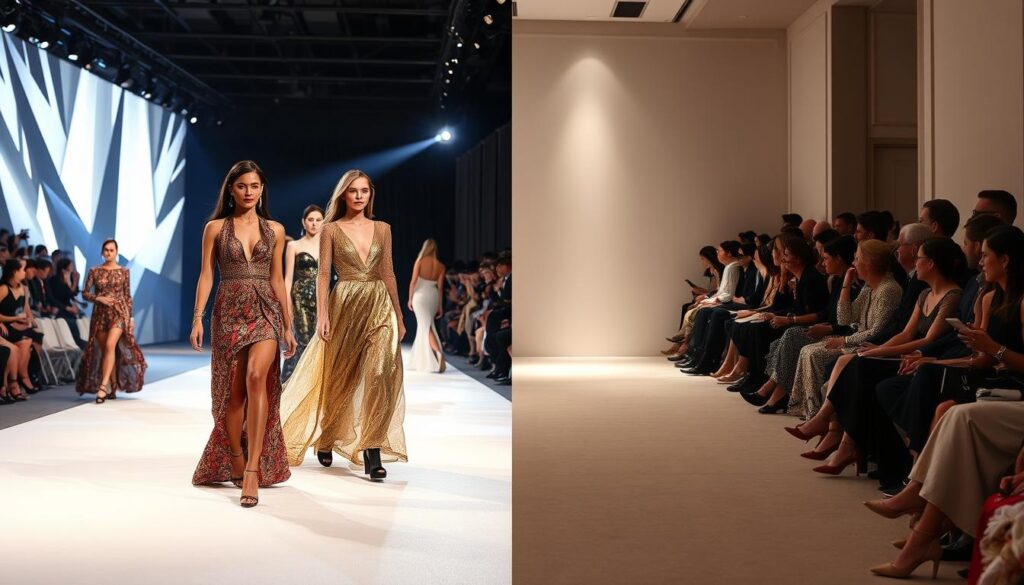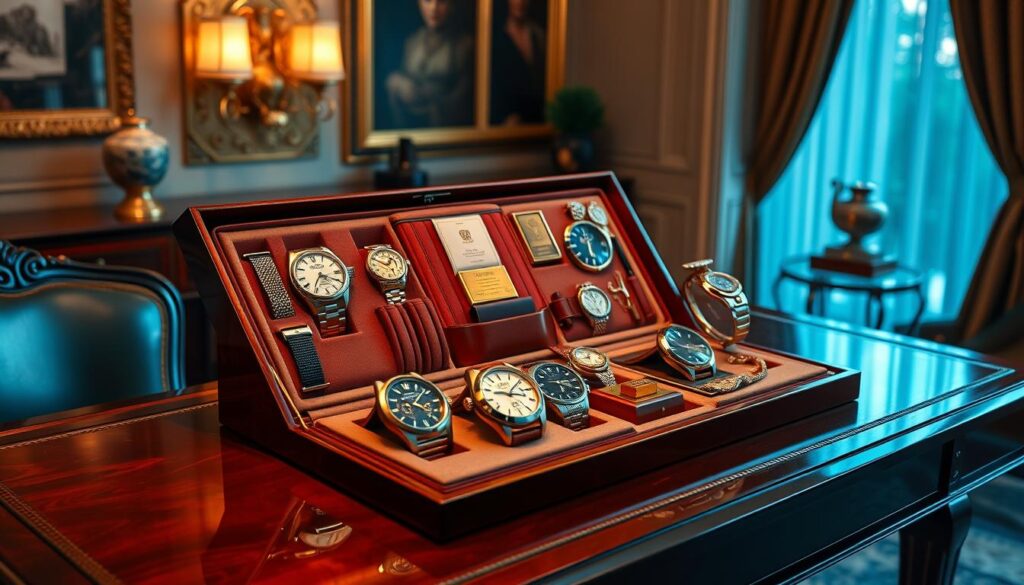I’ve always been fascinated by luxury assets as an investor. Building a portfolio that grows and reflects my style is appealing. Today, luxury investment strategies are a great way to increase wealth and enjoy the finer things.
The luxury sector is known for its exclusivity and prestige. But smart investors see its potential for growth. By carefully choosing and positioning luxury assets, you can diversify your portfolio and aim for high returns.

Key Takeaways
- Luxury investment strategies offer the opportunity to grow wealth while enjoying high-end assets.
- The luxury sector has demonstrated resilience, making it a compelling investment proposition.
- Diversifying your portfolio with luxury assets can provide financial and personal value.
- Active management and a thematic approach can help identify the most promising luxury investment opportunities.
- Understanding the evolving global luxury consumer landscape is crucial for informed investment decisions.
Understanding Luxury: Beyond Brands
Luxury is more than just fancy clothes and accessories. It includes top-notch cars, special experiences, and fine food and drinks. It’s not just about the brands we know. It’s about how luxury makes us feel and how it changes how we see ourselves.
The Luxury Pyramid: Segmenting the Market
The luxury market can be seen as a pyramid with different levels. At the top, we have the “Beyond” segment, with brands like Ferrari.
The “Absolute” level is next, with brands known for their high quality. These brands have a loyal customer base, even when money is tight.
The “High-End” segment is in the middle. Here, brands can see ups and downs, but their strength is key to success. At the bottom, we have the “Aspirational” tier. These brands aim to reach those who dream of luxury, but their success depends on strong brand appeal.
Smart investors, like Flavio Cereda, focus on brands with a solid history and loyal customers. They avoid the more unpredictable aspirational segment.
| Luxury Segment | Characteristics |
|---|---|
| Beyond | The pinnacle of luxury, represented by the most exclusive and aspirational brands (e.g., Ferrari) |
| Absolute | Well-established luxury brands with exceptional quality and a consumer base less sensitive to economic fluctuations |
| High-End | Brands with both positive and negative momentum, where brand strength plays a pivotal role |
| Aspirational | Brands targeted at consumers aspiring to luxury, heavily dependent on strong brand momentum |
By grasping the luxury market’s segmentation and brand hierarchy, investors can make better choices. They can benefit from the luxury sector’s enduring appeal.
Resilience of the Luxury Sector
The luxury sector has shown great strength over the last few decades. It has grown fast, even when the economy was tough. Experts say it has grown by 6% to 7% each year for 30 years. It has only had three bad years in the last three decades.
After COVID, the luxury world grew fast but then slowed down. Flavio Cereda, a top analyst, sees this slowdown as a sign of healthy growth. It’s not something to worry about.
Even with big drops, like Gucci’s 20% sales fall in the second quarter, the luxury world is strong. China is a big player, making up 16% of luxury spending last year. This shows the industry’s global appeal and growth potential.
The luxury world also depends on rich people wanting luxury goods. This has helped it stay strong during hard times. Now, brands are trying new things to grow again. They know they need to be creative in a competitive market.
The luxury sector is also good at changing with what people want. Now, people are looking for timeless styles, not just flashy ones. This ability to adapt and focus on quality and reputation has helped it survive tough times.
Even with a slowdown, the luxury goods market hit nearly $390 billion in 2023. This shows it’s grown a lot in the last 10 years. Though spending has dropped in some places, the industry is ready to bounce back soon.
The Evolving Global Luxury Consumer
The luxury market is changing fast, making it key to understand the global luxury consumer. Flavio Cereda, a top expert, says focusing on the Asian consumer is vital. Since 2016, they have become the biggest buyers of luxury goods. This change shows a big shift in how Chinese people spend their money.
Shift in Chinese Consumer Spending Patterns
Before COVID, most Chinese luxury spending happened abroad. But now, 70% of it happens in China. This big change shows how consumer habits are evolving. It highlights the need to look at global clusters, not just places.
The luxury world faces many challenges, like economic and political issues. Global luxury consumer trends, Chinese luxury spending, and domestic luxury consumption are key for brands and investors.
“The luxury industry leadership anticipates a challenging year in 2024 due to economic, political, and consumer-driven challenges.”
As the luxury world changes, brands are updating their plans. They’re using TikTok and focusing on community and sustainability. The industry is dealing with the fast pace of this market.
Winners and Losers: Brand Polarization
The luxury sector has shown great strength, growing by 6% to 7% each year for 30 years. It has only had three bad years in the last three decades. But, the post-pandemic world has shown a clear divide between luxury brand winners and losers.
Flavio Cereda, a luxury expert, says some brands are doing well, even in tough years like 2023. LVMH, the biggest luxury company, has almost doubled its share in fashion and more. But, smaller brands are finding it hard to stand out and stay financially strong.
| Luxury Brand | Market Share Shifts | Performance |
|---|---|---|
| LVMH | Nearly doubled global market share | Sales fell by 1%, net profit by 14% in H1 2023 |
| Hermès | Outperforming the industry | Sales surged by 15%, net income rose by 9% in H1 2023 |
| Kering | Lost significant ground | Sales dropped by 11%, operating profit by 42% in H1 2023 |
| Burberry | Dropped from FTSE100 index | Lost 75% of its share value since April 2023 |
The growing luxury brand polarization shows how crucial it is for smaller brands to stand out. As the market share shifts, the luxury brand performance will decide who wins and loses in the luxury world.
“Even in a challenging year like 2023, certain brands are thriving while others struggle. LVMH has nearly doubled its global market share in fashion, leather goods, watches, and jewelry, while other brands have lost significant ground.”

Luxury Investment Strategies
The GAM Luxury Brands Fund: A Thematic Approach
The GAM Luxury Brands Fund is a unique way to invest in luxury. Its manager, Flavio Cereda, uses a “daisy chart” model. This puts luxury brands at the center, surrounded by related sectors.
About 50% of the fund is in top luxury brands like Ferrari and Prada. Cereda doesn’t see Mercedes and Porsche as true luxury brands. This makes the fund different.
The fund goes beyond just luxury goods. It also invests in luxury experiences, like high-end hotels and Viking Cruises. It even includes luxury gym equipment and yacht makers for the very rich. This strategy helps the fund keep up with changing tastes.
| Sector | Allocation |
|---|---|
| Luxury Brands | ~50% |
| Experiences (Luxury Hotels, Cruises) | ~25% |
| High-End Manufacturing (Gym Equipment, Yachts) | ~25% |
The GAM Luxury Brands Fund takes a thematic approach to investing. It aims to cover the whole luxury market. This gives investors a well-rounded portfolio.
The Importance of Active Management
In today’s fast-changing luxury investment world, active management is key. The luxury sector’s ups and downs mean you can’t just invest in a broad ETF. Active luxury investing through smart stock picking and portfolio management is vital. It helps you make the most of new chances and challenges.
Flavio Cereda, an expert, says picking the right luxury brands is crucial. He points out that active management is especially important in a competitive market. By keeping a close eye on investments, managers can spot trends, reduce risks, and offer better returns.
The luxury investment scene is changing fast. It’s influenced by new consumer tastes, tech, and market shifts. Being able to adapt and make smart choices is essential. Active management lets you find and invest in new luxury opportunities, keeping you ahead.
LUXUS, a new player, shows the power of active management in luxury. It recently raised $5M to give investors a chance to dive into luxury assets. By working with brands and using tech, LUXUS aims to increase the value of its clients’ investments.
As the luxury world keeps evolving, active management will be crucial for investors. By understanding the market’s details, managers can tackle its challenges and seize its unique opportunities.

Luxury Investment Strategies: Capitalizing on Opportunities
In the fast-changing world of luxury, smart investors can make the most of this sector’s growth. By choosing the right luxury investment strategies, you can unlock the full potential of high-end assets. This way, you can build a stylish portfolio that lasts.
One effective strategy is to focus on active management. The luxury market is getting more competitive. The GAM Luxury Brands Fund, for example, targets the best brands and sectors. This approach helps investors stay ahead and grab the opportunities in the luxury world.
“With the right focus on key brands and sectors, the GAM Luxury Brands Fund aims to capture the full potential of the ever-evolving luxury landscape, enabling investors to capitalize on the opportunities presented by the resilient and dynamic luxury market.”
Luxury real estate is also a great investment area. Cain International, a top global investment firm, manages over $16 billion. Their portfolio includes luxury properties with brands like Aman, Delano, and Raffles. With more HNWI expected, the demand for top real estate will stay strong, making it a smart choice.
By choosing active management and focusing on the best luxury opportunities, you can grow your portfolio. This way, you can make the most of the luxury sector’s resilience and growth.
Conclusion
Investing in luxury real estate is a unique way to grow your wealth. The luxury sector is strong and real estate is a solid investment. This makes it a great choice for those looking to build wealth over time.
Understanding the luxury real estate market is key. Knowing about segmentation and changing consumer trends helps you make smart choices. You can use luxury real estate to grow your wealth, get tax benefits, or diversify your investments.
The main points about luxury investing are important. Real estate is less risky than stocks and can protect against inflation. It also has the chance for big returns through property value increase and mortgage equity growth. By looking at location, quality, and rental potential, you can find the best luxury real estate.
Also Read: Consumer Venture Capital: Investing in Innovation
FAQ
What is the luxury pyramid and how does it help in segmenting the luxury market?
The luxury pyramid divides luxury brands into four segments. The top is “Beyond,” with brands like Ferrari. Then there’s “Absolute,” known for high quality and less sensitive to economic changes.
Next is “High-End,” where brand strength is key. Finally, “Aspirational” targets those who dream of luxury but need strong brand momentum.
How has the luxury goods sector demonstrated resilience over the past decades?
The luxury goods sector has grown steadily, with 6% to 7% annual growth for 30 years. It has only had three bad years in the last three decades.
How is the luxury sector experiencing brand polarization?
In 2023, some luxury brands are doing well, while others are struggling. LVMH has nearly doubled its market share in fashion and more. But smaller brands face tough competition and must stand out financially.
What is the investment strategy of the GAM Luxury Brands Fund?
The GAM Luxury Brands Fund uses a “daisy chart” model. It focuses on luxury brands (about 50% of the portfolio) and related sectors. It invests in Ferrari, Prada, and Cucinelli, but not in Mercedes or Porsche, as they’re not seen as true luxury brands.


